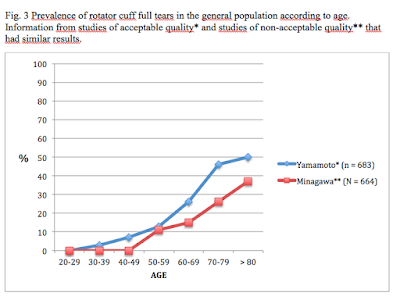These authors attempted to determine the prevalence estimates for rotator cuff partial or complete tears and to relate this prevalence to the prevalence of self-reported nontraumatic shoulder pain.
Their results remind us that the prevalence of rotators cuff lesions increases gradually after 50 years, whether on correlates clinical clinical findings with person age in the general population (see this link).
or whether one correlates cadaver findings with cadaver age
These data suggest that about 50% of 70 year old people have a partial or complete rotator cuff defect. Because degenerative cuff defects usually progress slowly with time the shoulder and the patient have time to successfully accommodate to the loss of cuff integrity(see this link).
Rotator cuff tear and rotator cuff wear.
"The rotator cuff is the only tendon structure situated between two bones. Compressed between the acromion and the humerus by every motion of the shoulder, it succumbs to the ravages of attrition long before most other tendons. In youth, it is thick, strong, and elastic and can be disrupted only by great force; after middle age, it has worn thin and often becomes so weak and brittle that it ruptures with ease." McLaughlin 1962
Detachment of the rotator cuff tendons from the greater tuberosity is often described as a rotator cuff tear. The word 'tear' suggests an acute process, such as tear in otherwise great blue jeans that can be easily repaired.
On the other hand, most cuff defects arise in tendons of suboptimal quality without an acute traumatic episode and may be better referred to as cuff wear, similar to defects in worn jeans that defy repair.
We emphasize the distinction in an article on rotator cuff failure in the New England Journal as well as in the text, The Shoulder, where we quote McLauhglin's admonition regarding 'rotten cloth to sew' in an Instructional Course Lecture: "The wise surgeon, realizing that he may find little but rotten cloth to sew, will operate only by necessity and make a carefully guarded prognosis. [There was complete agreement of the Panel on this point.]" See these links to his work
Lesions of the musculotendinous cuff of the shoulder. The exposure and treatment of tears with retraction. 1944.
"The rotator cuff is the only tendon structure situated between two bones. Compressed between the acromion and the humerus by every motion of the shoulder, it succumbs to the ravages of attrition long before most other tendons. In youth, it is thick, strong, and elastic and can be disrupted only by great force; after middle age, it has worn thin and often becomes so weak and brittle that it ruptures with ease." McLaughlin 1962
Detachment of the rotator cuff tendons from the greater tuberosity is often described as a rotator cuff tear. The word 'tear' suggests an acute process, such as tear in otherwise great blue jeans that can be easily repaired.
On the other hand, most cuff defects arise in tendons of suboptimal quality without an acute traumatic episode and may be better referred to as cuff wear, similar to defects in worn jeans that defy repair.
We emphasize the distinction in an article on rotator cuff failure in the New England Journal as well as in the text, The Shoulder, where we quote McLauhglin's admonition regarding 'rotten cloth to sew' in an Instructional Course Lecture: "The wise surgeon, realizing that he may find little but rotten cloth to sew, will operate only by necessity and make a carefully guarded prognosis. [There was complete agreement of the Panel on this point.]" See these links to his work
Lesions of the musculotendinous cuff of the shoulder. The exposure and treatment of tears with retraction. 1944.
Rupture of the rotator cuff.
=
Check out the new Shoulder Arthritis Book - click here.
Use the "Search" box to the right to find other topics of interest to you.
You may be interested in some of our most visited web pages including:shoulder arthritis, total shoulder, ream and run, reverse total shoulder, CTA arthroplasty, and rotator cuff surgery as well as the 'ream and run essentials'




